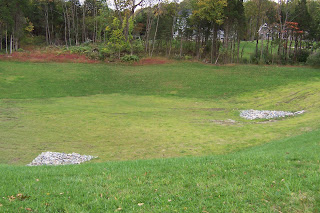Making Your Creative Mark In Gardening – Part 2
This is the second excerpt from a new book by America’s foremost creativity coach and my writing mentor, Dr. Eric Maisel. It’s called, Making Your Creative Mark. I’ve added editorial comments to the excerpt to help you see how you can use Eric’s suggestions to express more of your own creativity in the garden.
ERIC: 4. Complete projects for the sake of making progress. When you make new work that you think aims you in the direction of your genuine voice, try to complete that work rather than stopping midway because “it doesn’t look right” or “it isn’t working out.” You will make more progress if you push through those feelings, complete things, and only then appraise them. It is natural for work that is a stretch and new to you to provoke all sorts of uncomfortable feelings as you attempt it. Help yourself tolerate those feelings by reminding yourself that finishing is a key to progress.
LOIS: Sooner or later, every gardener finds him/herself in the middle of a big project and thinking, “What have I done?” This type of panic usually sets in at the peak of visual disarray, when it is too late to go back and too soon to see any improvement. The natural reaction is to second-guess ourselves, and suffer mounting dread that we may have made an irreversible and very expensive mistake. The only way out is through the mess and through the fear. At moments like this, it helps to recall past garden project successes and realize that this is the same process, just on a larger scale.
ERIC: 5. Think at least a little bit about positioning. You may want to develop your voice independent of art trends and say exactly what you want to say in exactly the way you want to say it. On the other hand, it may serve you to take an interest in what’s going on and make strategic decisions about how you want to position yourself vis-à-vis the world of galleries, collectors, exhibitions, auctions, movements, and so on. It isn’t so much that one way is right and the other is wrong but rather that some marriage of the two, if you can pull it off, may serve you best: a marriage, that is, of marketplace strategizing and of intensely personal work that allows you to speak passionately in your own voice.
LOIS: Gardening trends and fads develop very similarly to the fashion industry and are cyclic. “Black” plants were” in” one year and “out” the next. Whether hot pinks or cool blues strike your fancy, it’s best to choose what you can love for a long time when selecting shrubs and perennials, which are the foundation of the garden. Save the sparkly stuff for container plants and annuals. Those trendy colors are meant to pop and they’ll show up best against the garden’s primary neutral color – green. Strategically position the trendy plants where they can easily be replaced by next year’s latest thing, while keeping the essential personality of the garden intact.
ERIC: 6. Try to articulate what you re attempting. Artists are often of two minds as to whether they want to describe what they are attempting. Paraphrasing a visual experience into a verbal artist’s statement often feels unconvincing and beside the point. On the other hand, it can prove quite useful to announce to yourself what you hope to accomplish with your new work. By trying to put your next efforts into words, you may clarify your intentions and as a consequence more strongly value your efforts. The better you can describe what you are doing, the better you may understand your artistic voice — and the more passionate you can be in talking about your work.
LOIS: A gardener’s statement should convey what you hope to accomplish by molding the natural world into a controlled space. Wildlife habitat? Display space for a sculpture collection? Kid’s adventure land? Science experiment? While a landscape plan is an important map to show how the garden can get where it is supposed to go, it doesn’t help in determining the destination. Too many gardeners skip this crucial step and just dive right in with hiring a contractor, a designer, or even doing it themselves, before they’ve established in their own mind what they want to express by constructing the garden in the first place. Do this part at the outset and you won’t be disappointed with the result. It’s the slow, fast way.
Excerpted from the new book Making Your Creative Mark ©2013 by Eric Maisel. Published with permission of New World Library http://www.newworldlibrary.com


